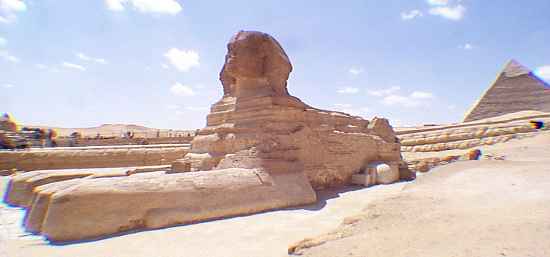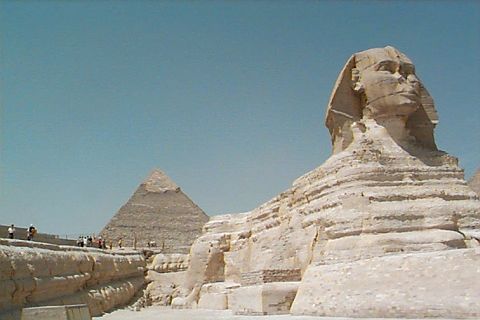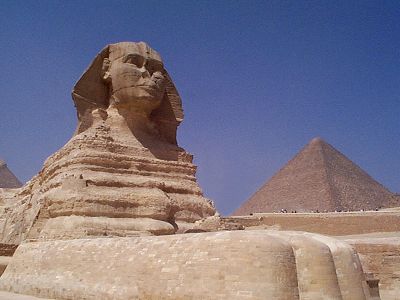The Sphinx of Giza is a symbol that has represented the essence of Egypt for thousands of years. Even with all of the pictures that we see of the Sphinx, nothing can really prepare you for the time that you finally see the Sphinx with your own eyes. Here's a look at the Sphinx that will give you a hint of what you can
expect to see if you visit Egypt

Carved from the bedrock of the Giza plateau, the Sphinx is truly a mysterious marvel from the days of ancient Egypt. The body of a lion with the head of a king or god, the sphinx has come to symbolize strength and wisdom
From the north side the profile of the Sphinx reveals the proportion of the body to the head. It would appear as though the head is small in proportion to the body. Because of the changing desert terrain, the body of the Sphinx has been buried several times over the past several thousand years. Most recently in 1905, the sand has been cleared away to expose the magnitude and beauty of the entirety of the Sphinx. The paws themselves are 50 feet long (15m) while the entire length is 150 feet (45m). The head is 30 (10m) feet long and 14 feet (4m) wide. Because certain layers of the stone are softer than others, there is a high degree of erosion that has claimed the original detail of the carved figure
.
Although the head of the Sphinx is badly battered in some places, traces of the original paint can still be seen near one ear. Originally it is believed that the Sphinx was painted and was quite colorful. Since then, the nose and beard have been broken away. The nose was the unfortunate victim of target practice by the Turks in the Turkish period. It is often erroneously assumed that the nose was shot off by Napoleon's men, but 18th century drawings reveal that the nose was missing long before Napoleon's arrival.

Rounding the southeast corner where it now lies badly damaged. Some believe that Khafre usurped the throne of Djedefre and then built his pyramid and Sphinx at Giza.
Interestingly, to some, the features of the face of the Sphinx bear a far more striking resemblance to an older brother of Khafre, the Pharaoh Djedefre (AKA Radjedef). Djedefre's short lived reign occurred just prior to the reign of Khafre. Unlike Khafre, Khafre's father and later Khafre's brother Menkaure, Djedefre did not construct his pyramid on the Giza plateau. Instead Djedefre built his pyramid at

Recently, the Sphinx has undergone a major restoration effort, done solely by Egyptians. Here is how the back right paw appears after this fine work. The top of the paw was purposely left unfinished, which demonstrates the difference between the original rock and the quality of the restoration. Also notice the tail of the Sphinx which wraps around this right side.
Egyptian relics - The Curse of the Pharaohs
- the secret of mummification - Magic at the Pharaohs - Luxor - Sphinx -
Pyramids - The Temple
of Karnak - The Temple of Abu Simbel - Temple of Ramses II - Akhenaten -
Tuthmosis III - Tutankhamun - Pharaoh - Nefertiti - Cleopatra -
Nefertari - Hatshepsut -

No comments:
Post a Comment